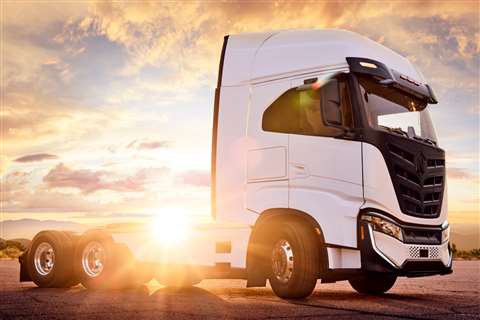Street Smarts: Trucking industry called to net zero action at ACT Expo
21 June 2022
 The dominant message of ACT Expo was the need to put technologies like the Nikola zero-emission semi-trucks to work in real-world fleets if the trucking industry is to meet its 2050 net zero goals. (Photo: Proterra)
The dominant message of ACT Expo was the need to put technologies like the Nikola zero-emission semi-trucks to work in real-world fleets if the trucking industry is to meet its 2050 net zero goals. (Photo: Proterra)
With its laser-like focus on new technologies for the North American and global trucking industries, the Advanced Clean Transportation Expo (ACT Expo) has emerged as one of the most important events for the commercial vehicle industry.
For over a decade, ACT Expo was a lone voice in the wilderness, calling for a cleaner and greener future for trucking. Then, as government mandates began to earmark clear deadlines for an eventual transition to a “net zero” carbon emissions future for North American trucking, the show became a vital source of information on what new technologies were the most promising and how they would conceivably perform in real-world fleet operations. Over the past several years, as many of those technologies – battery-electric vehicles (BEVs) in particular – developed to the point where they were ready for scale production, the mood at the show teetered on the edge of giddiness at the prospect of so many new, promising technologies coming to fruition in a relatively short period of time.
Mind you, given the incredible amount of work in the alternative fuels space done by OEMs, suppliers and startups over the past decade, this celebratory mood was well-deserved. But at last month’s ACT Expo 2022 in Long Beach, Calif., I discerned a more sober, reserved sense of purpose among the speakers at various panel discussions and forums, at press conferences and during booth visits.
Sense of purpose
Now, with some technologies like BEVs on the cusp of full-scale production, and others, like hydrogen fuel cells and alt-fuel internal combustion engines, advancing at a surprisingly rapid pace, a more sober, reality-based assessment of where things stand in the quest for a net zero trucking industry is taking root.
That’s because, in stark terms, it’s time to put these technologies to work and allow them to stand – or fall – on their own merits in real-world fleet operations. It means actually handing over large numbers of trucks laden with new technologies to fleets, who will have to figure out how to merge them into their operations, determine how best to deploy them and begin to uncover their new maintenance secrets in ways that will allow them to obtain optimal efficiency and TCO from these new, futuristic assets.
In real-world terms, that’s going to mean making a lot of adjustments for fleets, which will now have to revisit procedures that have been set in stone for decades – things like daily range considerations, maintenance intervals and refueling procedures, to name but a few.
Modern commercial vehicle fleet management is, in essence, a never-ending learning curve. But it’s been a long time since the trucking industry has been handed so many learning curves to master all at once. That’s without factoring in the daunting work that still must be done to bring multiple infrastructures for each new technology up to a level sufficient to support vehicles “out in the wild.”
And that’s just the view from the ground level.
‘Not good enough’
A sober reassessment of where things stand when viewed from 30000 ft. also took place at the show. In separate keynote addresses, Volvo Trucks North America CEO Peter Voorhoeve, new Navistar CEO Mathias Carlbaum and Cummins CEO Tom Linebarger all stressed that despite the incredible progress made by the trucking industry over the past decade, it is simply not enough to get the industry to its net zero goal by 2050.
 Jack Roberts is a Tuscaloosa, Ala.-based independent journalist and licensed commercial driver with more than 20 years’ experience covering the North American and global trucking industries.
Jack Roberts is a Tuscaloosa, Ala.-based independent journalist and licensed commercial driver with more than 20 years’ experience covering the North American and global trucking industries.
“We have cut greenhouse gas emissions by 60% since 2010,” Carlbaum said. “But under our current technology path, we can only hope to cut emissions by another 15% in the next 20 years. And that is not good enough. There are already many countries in Europe that are already where the U.S. wants to be on carbon emissions by 2050. We have a clearly chosen path ahead of us, but we need to accelerate our progress along that path.”
There was in no way a negative message, takeaway or vibe coming from ACT Expo this year. Unquestionably, trucking has made incredible progress toward a greener, sustainable future. But there is still a tremendous amount of work to do to successfully achieve the daunting goals ahead.
And that was the dominant mood and message at ACT Expo.
STAY CONNECTED




Receive the information you need when you need it through our world-leading magazines, newsletters and daily briefings.
POWER SOURCING GUIDE
The trusted reference and buyer’s guide for 83 years
The original “desktop search engine,” guiding nearly 10,000 users in more than 90 countries it is the primary reference for specifications and details on all the components that go into engine systems.
Visit Now
CONNECT WITH THE TEAM








